
by Kate S. Zalzal Friday, August 19, 2016
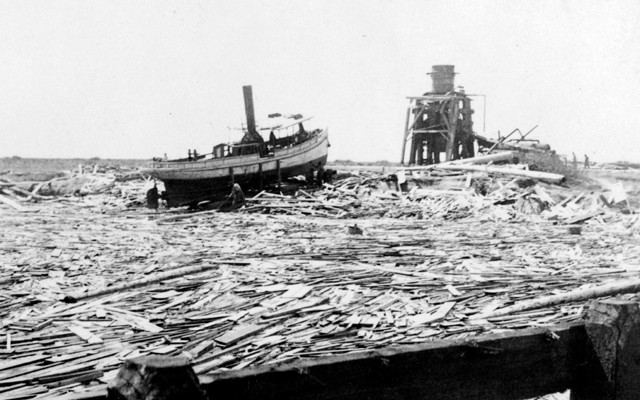
Wreckage in Galveston Bay near Texas City on the mainland. After the storm, debris clogged the Gulf Coast for miles. Credit: Library of Congress.
Everyone said it couldn’t happen. City leaders saw no need for an expensive seawall, trusting local meteorologist Isaac Cline when he claimed that it was “impossible for any cyclone to … materially injure the city.” And so, on the morning of Sept. 8, 1900, when the skies over Galveston, Texas, darkened with rain and the winds blew strong, residents of this booming barrier island community believed their city could weather any storm. By the next morning, the city lay in ruin, blasted by a Category-4 hurricane that killed an estimated 10,000 people — a quarter of the island’s population — and more than the combined death tolls of all other landfalling U.S. hurricanes since.
The storm that decimated Galveston on that day has no name; it wasn’t until the 1950s that the National Weather Service (then called the Weather Bureau) began its naming convention. In 1900, Richard Spillane, the editor of the Galveston Tribune, aptly named it the “Storm King.” More than half of the buildings in Galveston were destroyed, blown apart by winds estimated at up to 240 kilometers per hour or lifted from their foundations and tossed by the 5-meter storm surge that swept over the island. In the face of utter destruction, the survivors rallied, quickly setting their sights on recovery, determined to rebuild their community.
Located on a barrier island about 70 kilometers southeast of Houston on Texas’ Gulf Coast, Galveston has a rich and colorful history. Native Americans, who hunted and fished in its swampy marshland, were the original occupants of the island. Spanish explorers, French merchants, and even pirates followed. The city was incorporated in 1839 and was, for a brief time, the capital of the Republic of Texas.
By 1900, Galveston was a vibrant regional center, outpacing its rival, Houston, in many regards. It was a hub of immigration, banking and trade, operating the biggest cotton port in the country. As one of the wealthiest cities in Texas, Galveston’s booming population of nearly 40,000 at the turn of the century enjoyed many of the new technologies of the age, including electric streetcars and lights, telephone service, and progressive medical care. Galvestonians were proud of their cosmopolitan city with its opera house, grand Victorian homes, restaurants and hotels.
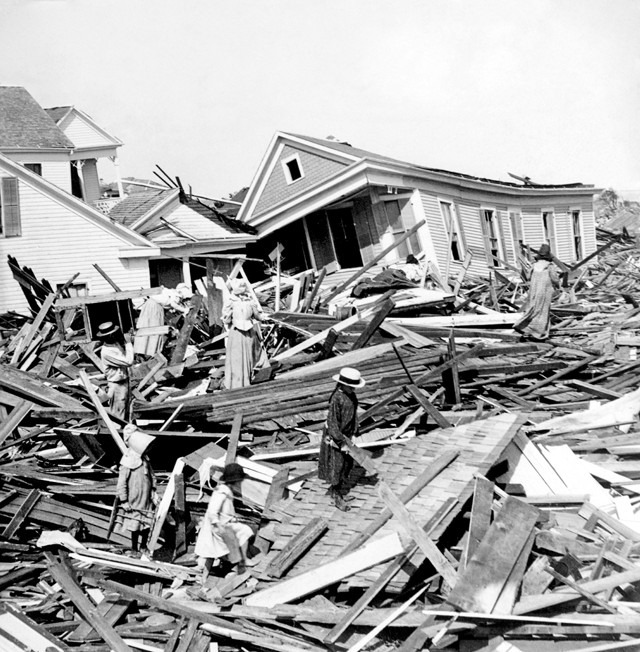
A family digs through the rubble of destroyed homes. Credit: Library of Congress.
Bustling and vibrant though it was, the city was physically vulnerable. Built on a low, flat, sandbar-type barrier island about 50 kilometers in length and less than 5 kilometers wide, Galveston’s highest point in 1900 was only 2.6 meters above sea level. Galveston residents were not unfamiliar with major tropical storms. Indianola, 145 kilometers southwest down the Texas coast, was hit by a hurricane and nearly destroyed in 1875, and again in 1886. Railroad investors, who had hoped to connect the settlement to the mainland, closed up shop in the twice-destroyed town, moving their operations to Galveston. Today, Indianola is a ghost town.
Adding to Galveston’s precarious geography was that sand dunes on the seaward side of the island — which had acted as a natural barrier between Galveston and the Gulf — had been removed and used to fill in low-lying areas of the growing city.
In the decade leading up to the disaster, discussions of building a seawall for Galveston had met with opposition. Why build such an expensive structure when respected leaders in the community believed the city was exempt from a fate like Indianola’s? Cline, head of the Galveston office of the U.S. Weather Bureau, wrote in an article for the Galveston Daily News that “the coast of Texas is, according to the general laws of the motion of the atmosphere, exempt from West India hurricanes and the two which have reached it followed an abnormal path which can only be attributed to cause known in meteorology as accidental.”
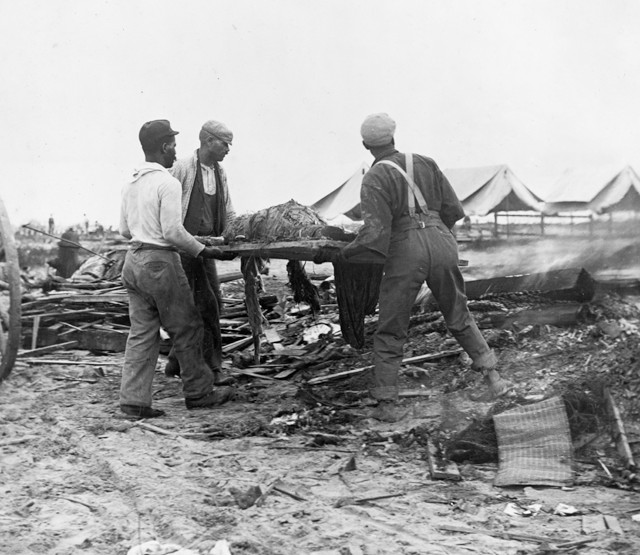
Bodies, which could not be buried in the soggy ground or at sea, were burned on funeral pyres lit throughout the city. Credit: Library of Congress.
The U.S. Weather Bureau knew of the storm as early as Aug. 30. It drenched Cuba on Sept. 4. Cline received multiple storm reports that week, but amid a growing power struggle over who could issue storm warnings, the bureau chief in Washington, D.C., downplayed Cuban reports that the hurricane was likely heading west. Without ship-to-shore communication, forecasters lost track of the storm just as it intensified in the warm waters of the Gulf of Mexico and headed straight toward the Texas coast.
Cline may have thought that severe hurricane damage to Galveston was an “absurd delusion,” but he was one of the first within Galveston to realize a storm was coming. The day before the hurricane hit, Cline had noticed a heavy swell from the southeast that continued into the night. The unusually high tide was even more concerning given that the wind was from the north and northwest, which would normally help hold rising waters at bay. Eventually, the Weather Bureau placed Galveston under a storm warning and on Sept. 7, Cline ordered hurricane flags to be flown.
Survivors later shared their surprise at being hit with such a storm. Even as conditions deteriorated, there was little talk among the townspeople of the approaching hurricane, let alone its intensity. The short updates in the daily papers had few — and sometimes contradictory — details, and were seen as mostly a warning to mariners rather than to those living on Galveston’s tree-lined streets. Whatever Cline and others at the Weather Bureau intended, the people of Galveston did not get the message.
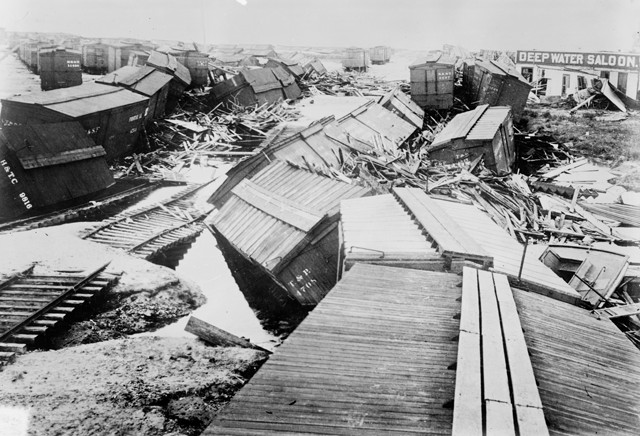
The wreckage of the train yard after the Galveston hurricane. Credit: Library of Congress.
As the storm crashed ashore on Sept. 8, the winds picked up and the barometric pressure plummeted. Limited to the tools of the day — a barometer, an anemometer to measure wind speed, and a raingage — Cline and others at the Weather Bureau tried to take detailed measurements of the storm. They got the last of the messages regarding the hurricane’s severity out to Washington in midafternoon before all the wires went down.
Hurricane force winds began blowing off roofs and hurling timbers and slate shingles through the air that afternoon. Around 6 p.m., still two hours before the eye of the storm passed near the city, the anemometer measured 160-kilometer-per-hour winds before it was blown off the roof of the Weather Bureau. Winds as high as 240 kilometers per hour were later estimated, with gusts of perhaps 320 kilometers per hour. (In 2008, Hurricane Ike pummeled Galveston with similarly ferocious winds.) Much of the city flooded. As a hurricane spins, surface winds rush inward — then soar upwards in the wall of the storm’s eye, creating a zone of low pressure. The pressure bottomed out at 723.4 millimeters in Galveston, the lowest reading ever recorded by a station of the U.S. Weather Bureau at the time.
Houses near the beach crumbled first. Wind and waves then hurled debris from these buildings into other structures and into people as they desperately tried to retreat inland. As the evening wore on, the water began to rise faster. “The water … was about eight inches deep in my residence,” Cline later wrote, “and the sudden rise of 4 feet brought it above my waist before I could change my position.” The storm surge arrived around 7:30 p.m. Many houses, battered by hours of wind, succumbed to the bank of water that rushed over the island. Shortly afterward, the entire city was under as much as 5 meters of water.
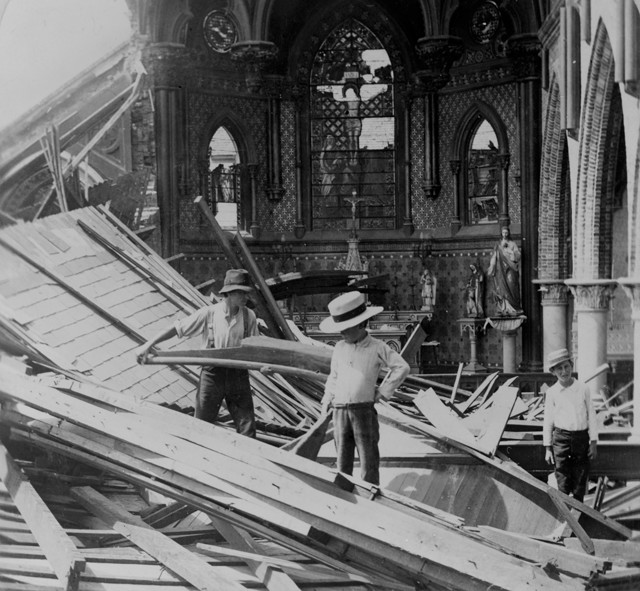
Boys look through the rubble of St. Patrick's Church. Credit: Library of Congress.
At the time, many homes were not actually secured to their foundations, and were lifted and carried away when the waters came. One woman, realizing what was happening, chopped holes into the floors of the first-floor rooms “so the water would come up into the house and hold the house on the ground.”
Forty to 50 people sought shelter in Cline’s sturdy home during the hurricane. But it too fell, smashed by the battering ram of water and debris. Of the refugees in his home, he later wrote, “all but eighteen were hurled into eternity,” including his pregnant wife. Cline and his three daughters survived, drifting on debris for many hours into the night. By midnight, the worst of the storm was over.
Those who survived until morning faced new crises: finding food and water, caring for the injured, and dealing with the dead and their destroyed city. It was difficult to get on or off the island as roads, railroad trestles and docks were demolished. “Loss of life and property undoubtedly most appalling,” read a telegram sent after the storm, describing what those attempting to get to Galveston by train discovered. The train was forced to stop 10 kilometers from the coast, unable to continue as the “prairie was strewn with debris and dead bodies.”
The magnitude of the disaster grew as more bodies were uncovered. Survivor accounts tell, in horrifying detail, the grim task they faced in disposing of the dead. There were too many to bury in the soggy ground. Many of those buried at sea washed back to shore. Afraid of disease outbreaks and desperate to get rid of the stench, residents lit fires at several sites in the city to function as funeral pyres, which burned for weeks.
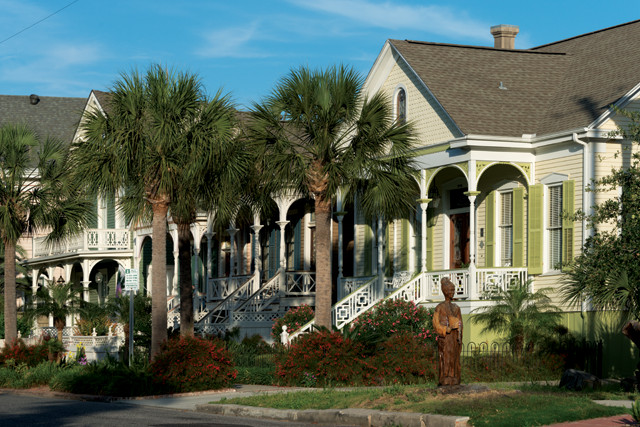
Tourists in Galveston can now take guided tours through the city, visiting dozens of trees killed by Hurricane Ike in 2008, which have been carved into sculptures. Credit: Library of Congress.
Survivors quickly focused on recovery. Defiant and determined in the face of nature’s wrath, they voted to build a massive defensive seawall. Over the next decade, a 5.6-kilometer-long seawall was built, standing 5.6 meters above mean low tide. The seawall has been extended multiple times since then, and now stretches nearly 17 kilometers.
Galveston also began the monstrous project of raising the entire city. Sand was pumped from the Galveston harbor, raising the grade by more than 5 meters. Thousands of buildings, streetcar tracks and pipes were lifted. During the effort, people had to walk on wooden catwalks, raised as much as 3 meters off the ground in some blocks. The largest building raised was a more than 2,700-metric-ton church, boosted 1.5 meters off the ground with jacks — a feat of engineering at the time.
The hurricane also decimated plant life on the island. More than 10,000 new trees were planted in the decade following the storm. As they grew, the trees became an iconic part of historic Galveston, representing recovery and perseverance in the face of great loss.
Today, Galveston’s hurricane defenses remain a work in progress. The city has weathered several big storms since September 1900, most recently Hurricane Ike in 2008. Ike barreled across the Gulf of Mexico before slamming into Galveston, following much the same path as the storm of 1900. This time, however, the U.S. Weather Service issued a mandatory evacuation, warning of “certain death” for those who stayed (although it’s estimated that one-third of the population remained). The storm surge crested the seawall, and many low-lying areas were again wiped out. There were 17 reported deaths.
The saltwater that rushed over the island during Hurricane Ike again killed thousands of trees, leaving many still standing but suffocated by salt and sand. A new project to replant the island is underway. Proud Galvestonians couldn’t bear to have all the dead trees cut to the ground, so many trunks of the formerly towering Live Oaks have been carved into whimsical sculptures of mermaids, fish, pets and people — tributes to the place Galveston was, and is, as the cycle of destruction and restoration on Galveston Island continues.
© 2008-2021. All rights reserved. Any copying, redistribution or retransmission of any of the contents of this service without the expressed written permission of the American Geosciences Institute is expressly prohibited. Click here for all copyright requests.